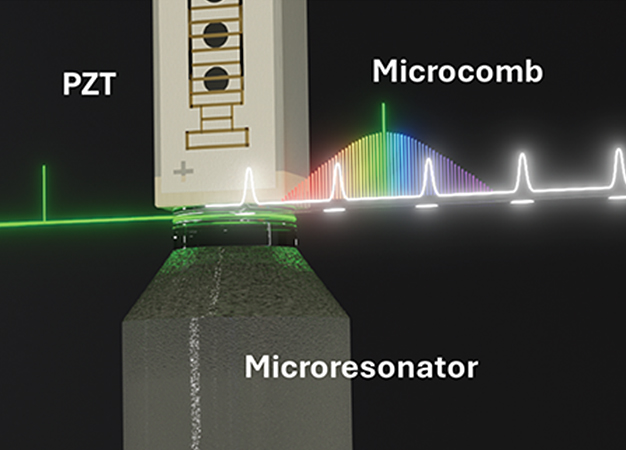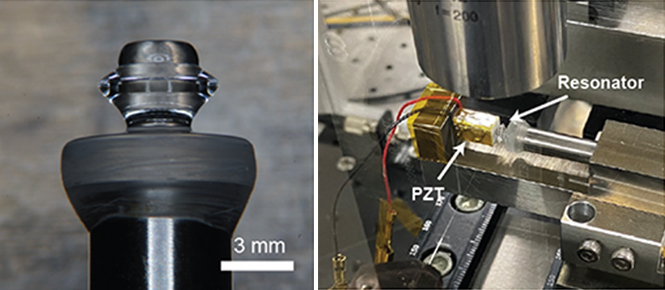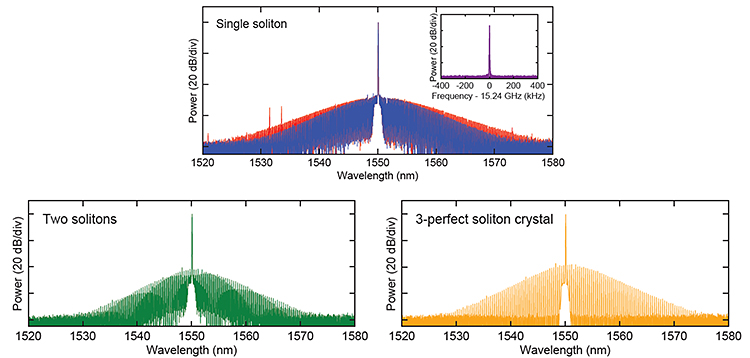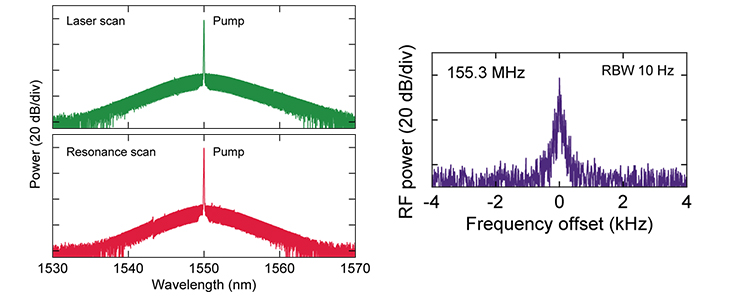Research outcomes of the Program for the Advancement of Next Generation Research Projects
Faculty of Science and Technology
Shun Fujii
A microresonator-based optical frequency comb, commonly referred to as a microcomb, is a next-generation laser light source that has garnered significant attention due to its compactness, integrability, high repetition rate, and broad spectral bandwidth.1 Optical frequency combs are a groundbreaking laser technology that contributed to the awarding of the Nobel Prize in Physics in 2005. A microcomb can be understood as a highly miniaturized version of such lasers, implemented at the device level. Of particular interest are soliton microcombs, in which all longitudinal optical modes are phase-locked in a mode-locked state. These soliton states emerge from a balance between strong optical nonlinearity and dispersion, allowing the formation of transform-limited ultrashort pulses in the time domain. Leveraging soliton microcombs enables coherent frequency bridging between the optical and microwave domains, which in turn unlocks a wide range of practical applications. These include high-capacity wavelength-division multiplexed communications, optical computing, dual-comb spectroscopy, precision distance measurement, and the generation of ultra-pure microwave signals.
In this study, we aimed to establish a more accessible method for generating microcombs and to develop a novel mechanism for enhanced frequency control. Figure 1 shows a concept of this research. Furthermore, we evaluated the performance of this new mechanism in the context of dual-comb spectroscopy applications. Specifically, we implemented a technique in which a piezoelectric actuator is used to apply mechanical pressure to a high-Q microresonator, thereby enabling rapid tuning of its optical resonance condition. This approach eliminates the need for precise wavelength control of the pump laser, which has traditionally been essential for microcomb generation. Additionally, we demonstrated high-speed modulation of soliton microcombs in response to voltage-driven actuation of the piezoelectric element. By employing this method, we successfully generated two microcombs with slightly different repetition frequencies and realized a highly coherent dual-comb system based on microcombs.

Figure 1:
Schematics of mechanically actuated microcomb generation. (Credit: Keio University)

Figure 2:
Photograph of an MgF2 microresonator (left) and experimental setup (right). (Credit: Keio University)
We first fabricated ultra-high-Q microresonators with quality factors exceeding 1 billion by precision machining and polishing a magnesium fluoride (MgF₂) crystal. We then developed a mechanism that enables a piezoelectric (PZT) to be directly attached to the microresonator (Fig. 2). This setup allowed for rapid control of the optical resonance modes without relying on frequency modulation of the pump laser. The design of the mounting structure and the choice of materials were thoroughly investigated using numerical simulations based on the finite element method. As a result, we found that using stainless steel enables higher frequency tuning efficiency. The typical modulation efficiency achieved experimentally was approximately 30 MHz/V, demonstrating that frequency tuning over several hundred times the resonance linewidth could be realized with just a few volts of applied voltage. Having confirmed that the system possessed sufficient performance for microcomb generation, we pumped the microresonator to generate a soliton microcomb with a frequency fixed continuous-wave laser. By applying a voltage sweep to the piezoelectric actuator, the cavity resonance frequency was rapidly swept relative to the fixed laser frequency. This frequency sweep triggered the generation of a soliton microcomb, producing a smooth spectral envelope as shown in Fig. 3.

Figure 3:
Optical spectra of observed soliton microcombs (Credit: Keio University)

Figure 4:
Optical spectra of dual combs (left). Measured heterodyne signal at radio-frequency domain (right). (Credit: Keio University)
The repetition frequency of the soliton pulses was measured using a high-speed photodetector and found to be approximately 15.2 GHz.2 By finely adjusting the applied voltage to the actuator, we were also able to experimentally observe multi-soliton states, such as two- and three-solitons. In addition, we demonstrated high-speed modulation of the repetition frequency with arbitrary waveforms by extending this technique, showcasing its potential for dynamic control applications.
Finally, we demonstrated a dual-comb system based on soliton microcombs.3 A dual-comb system is an interferometric technique that utilizes two optical frequency combs with slightly different repetition rates. When applying this concept to microcombs, maintaining high mutual coherence between the two combs is crucial. To achieve this, one microcomb was generated by sweeping the wavelength of the pump laser in the conventional manner, while the second was generated simultaneously by sweeping the resonance frequency of the microresonator using mechanical actuationーboth driven by the same continuous-wave laser source. This approach enables both microcombs to share a common pump laser, effectively eliminating the degradation in mutual coherence that typically arises when using independent optical sources (Fig. 4). The interference signal obtained from this dual-comb setup exhibited a beat linewidth below the measurement limit of 10 Hz, clearly demonstrating the high mutual coherence between the two combs. This level of coherence allows for coherent integration of the interferometric signal, paving the way for high-speed and high signal-to-noise ratio (SNR) dual-comb applications. Moreover, because the pump laser, optical amplifiers, and modulators can all be shared within the system, this method offers significant potential for simplifying the overall system architecture and reducing implementation costs.
Reference
- T. J. Kippenberg, A. L. Gaeta, M. Lipson, and M. L. Gorodetsky, Dissipative Kerr solitons in optical microresonators, Science 361, eaan8083 (2018).
- S. Fujii, K. Wada, S. Kogure, H. Kumazaki, and T. Tanabe, Mechanically Actuated Kerr Soliton Microcombs, Laser Photonics Rev. 18, 2301329 (2024).
- T. Murakami, K. Wada, S. Kogure, R. Takabayashi, L. Yang, R. Shibata, H. Kumazaki, S. Watanabe, A. Ishizawa, T. Tanabe, and S. Fujii, Architecture for coherent dual-comb spectroscopy and low-noise photonic microwave generation using mechanically actuated soliton microcombs, Opt. Lett. 50, 1417 (2025).
Keio University Program for the Advancement of Next Generation Research Projects
The Keio University Program for the Advancement of Next Generation Research Projects subsidizes research costs with the aim of finding solutions to challenges and of promoting global academic research in order to allow Keio University faculty members to establish a presence as core researchers.